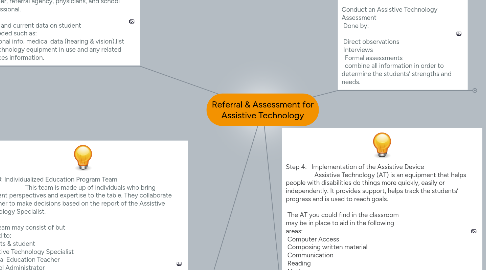Referral & Assessment for Assistive Technology
LaTonya Summersにより


1. Step 1: Referral for assistive Technology Students may be referred by: family member, teacher, referral agency, physicians, and school professional. Prior and current data on student is needed such as: personal info, medical data (hearing & vision),list of technology equipment in use and any related services information.
1.1. Tasks
1.1.1. Task 1
1.1.2. Task 2
2. Step 3: Individualized Education Program Team This team is made up of individuals who bring different perspectives and expertise to the table. They collaborate together to make decisions based on the report of the Assistive technology Specialist. This team may consist of but limited to: Parents & student Assistive Technology Specialist General Education Teacher School Administrator Social Worker Speech Pathologist Therapists (Physical & Occupational School Psychologist, Counselor, Nurse Their main goal is to set up a plan to improve educational results for children with disabilities.
2.1. Test-retest estimates of reliabilty
2.1.1. Task 1
2.2. Alternate-form estimates of reliabilty
2.3. internal consistnecy estimates of reliabilty
2.3.1. Split halves
2.3.2. Kudor-Richardson method
3. Step 2: Conducting an Assistive Technology Assessment Conduct an Assistive Technology Assessment Done by: Direct observations Interviews Formal assessments combine all information in order to determine the students’ strengths and needs.
3.1. Criterion-related validity evidence
3.2. Content-validity evidence
3.2.1. Task 1
3.2.2. Task 2
3.3. Construct validity evidence
3.3.1. Call 1
3.3.2. Call 2
4. Step 4: Implementation of the Assistive Device Assistive Technology (AT) is an equipment that helps people with disabilities do things more quickly, easily or independently. It provides support, helps track the students’ progress and is used to reach goals. The AT you could find in the classroom may be in place to aid in the following areas: Computer Access Composing written material Communication Reading Math Mobility Vision Hearing
4.1. Priority
4.2. Tasks
4.2.1. Task 1
4.2.2. Task 2
4.3. Phone Calls
4.3.1. Call 1
4.3.2. Call 2
4.4. Meetings
4.4.1. Meeting 1
4.4.2. Meeting 2
